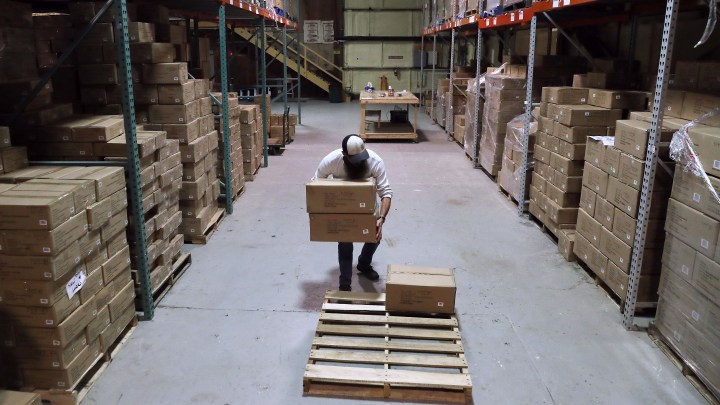
Why business owners are stocking up on inventory
Why business owners are stocking up on inventory

In business, there’s a common strategy known as just-in-time inventory management. The idea is to keep just enough product on the shelves in the warehouse or back room just in time for customers to buy it. Keeping as little inventory on hand as possible keeps stuff fresh, reduces waste and cuts down on storage and inventory costs.
But this year, many businesses are throwing the just-in-time strategy out the window and instead stockpiling inventory to make sure they have enough product on hand.
Brooklyn grocery store Sahadi’s imports a lot of products from the Mediterranean and the Middle East, and lately, a lot of those products are taking a long time to arrive.
“I’ve got import folders — it’s hysterical — where you see the ETA crossed out, cross out again, crossed out the third time, as they’re getting stuck,” said Pat Whelan, who manages the store’s shipping and logistics.
Supply chain backup
The problem, Whelan said, is the congested supply chain, which is slowing down imports all over the country. Ports are blocked up, transportation costs are skyrocketing and shippers are even having trouble finding containers to ship goods in.
“I had a shipper tell me they had five loads to ship to us, but they could only get two containers and won’t be able to get the other three containers till the end of June,” Whelan said.
As a result, Whelan said he’s doubling and tripling up on orders to create a buffer for any future delays. That means he’s ordering products today that he’d normally order months from now.
“If I get something four months early or six months early, who cares?” Whelan said. “Just get it moving. Don’t wait.”
Finding storage space
Once Whelan receives all those goods, he has to find a place to store them. That’s one reason why building up a buffer of inventory can be expensive.
Nathan Rogge, president and CEO of the Bank of Southern California, said many of the bank’s clients are increasing their lines of credit.
“They have bigger orders, they’re waiting for people they’ve sold to to pay them back, and in that time frame, they need money to buy more inventory,” Rogge said.
Some of them are even taking out loans to buy more storage space for all that inventory.
“We recently had to purchase a big warehouse,” said Eddy Barham, president of Appliance Home Store in Columbia, South Carolina.
Barham said he’s stocking up in part because prices are going up. He said he also wants to ensure he has enough appliances in stock to meet all the customer demand he’s seeing, thanks to government relief checks and a booming housing market.
“Some days, we’ll sell 30 refrigerators,” Barham said. “A real good week can clean out my warehouse.”
Limits on stockpiling
There are limits on how much businesses can stock up on inventory.
Brandelyn Green, the CEO and founder of VoiceOfHair, a hair product company, is getting ready to launch a new line of shampoos, conditioners and styling creams. But she’s not stocking up on the ingredients.
“I just don’t want things to go stale,” Green said. “I want people to get stuff when it’s fresh and new.”
But Green is stockpiling all the packaging she needs for those products.
“I’m ordering bottles, jars, disc caps and all types of closures to house that product in,” she said.
Green said she’s been making decisions on when to launch products based on the availability of packaging. For instance, she launched a line of gummy vitamins for healthy hair in large part because they come in plastic bottles.
“I’ve been able to get that packaging easier,” Green said. “Because my tops aren’t shiny, they’re not metal, they’re made out of plastic, so they’re a little easier to come by.”
In the meantime, Green’s stocking up on the fancier, shiny packaging she wants to use for her shampoos and creams.
“When the opportunity comes and when I realize, ‘Hey, it’s summer, everyone wants a new cleansing shampoo,’ then I can go ahead and produce that without having to wait,” Green said.
And once those products launch, Green said she should have enough packaging in store to last three to four months.
There’s a lot happening in the world. Through it all, Marketplace is here for you.
You rely on Marketplace to break down the world’s events and tell you how it affects you in a fact-based, approachable way. We rely on your financial support to keep making that possible.
Your donation today powers the independent journalism that you rely on. For just $5/month, you can help sustain Marketplace so we can keep reporting on the things that matter to you.


















